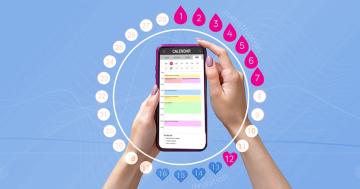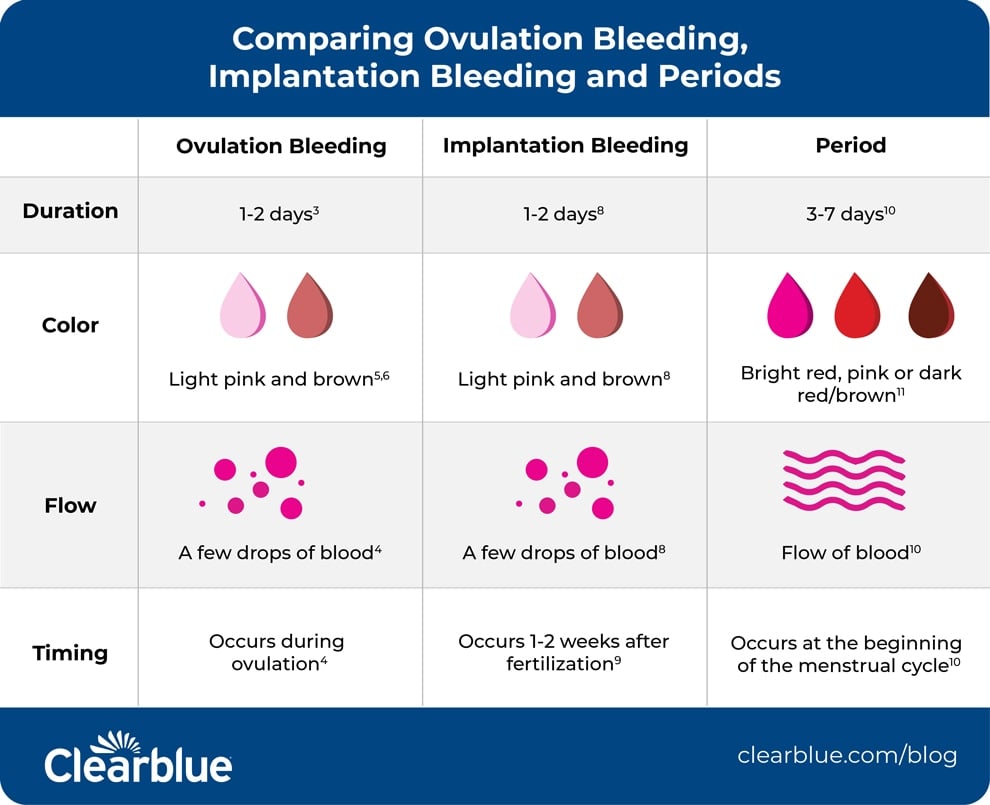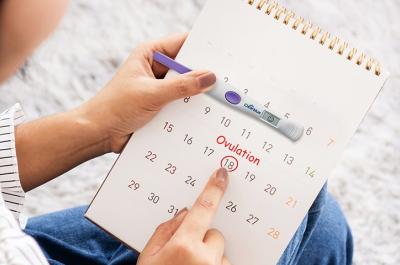Understanding ovulation bleeding

Do you sometimes experience light bleeding or spotting in the middle of your cycle, around the time you ovulate? If so, it’s important to reach out to your doctor as soon as possible to understand the cause.1 Learn why ovulation bleeding might occur, what to expect if it does and how it differs from other types of uterine bleeding.
Why am I bleeding during ovulation?
Light bleeding or spotting in the middle of your cycle can have many different causes — which is why it’s so important to talk to your doctor if you experience it.1 The potential causes of ovulation bleeding or midcycle spotting include:
- Mittelschmerz: During ovulation, a follicle ruptures and releases an egg into the Fallopian tube.2 This process happens quickly and may be accompanied by mittelschmerz (German for “middle pain”). Along with this pain, which can last anywhere from a few minutes or hours to a day or two, light bleeding and spotting can occur.2
- Fluctuating hormones: According to a 2012 study in the American Journal of Epidemiology, people who reported midcycle spotting had higher peak luteinizing hormone (LH) levels and higher levels of estrogen and progesterone during their luteal phase compared to others in the study.3
- Other health issues: An underlying medical condition may cause abnormal bleeding outside your period — talk to your doctor for a diagnosis.1
Bleeding during ovulation is not common — only about 5% of individuals experience it, and typically not every cycle.3
What does ovulation bleeding look like?
Ovulation bleeding is typically very light, and you may only experience spotting.4 It’s not the same as your period: Ovulation bleeding can vary in color and may look more like pink discharge, usually due to the cervix producing more cervical mucus around this time.5,6
When does ovulation bleeding occur?
Ovulation bleeding and spotting happens around the time you ovulate, which is also when you are most fertile.4 Because menstrual cycle lengths can vary from person to person and month to month, it can be difficult to know exactly when you ovulate.
Ovulation usually happens 12 to 16 days before your next period.7 Tracking your ovulation with a home ovulation test such as the Clearblue®Advanced Digital Ovulation Test can help you pinpoint your most fertile days.
How long does ovulation bleeding last?
Ovulation bleeding or spotting typically only lasts one or two days.3 If the cause is mittelschmerz, midcycle bleeding may only occur once during your cycle, when the follicle ruptures and releases the egg.2
Ovulation bleeding vs. implantation bleeding
The biggest difference between ovulation bleeding and implantation bleeding is timing. Ovulation bleeding occurs during ovulation, about halfway through the cycle. Implantation bleeding occurs about six to 12 days after fertilization, when the egg implants into the lining of the uterus — some people may mistake it for a period.8
What does implantation bleeding look like compared to ovulation bleeding or a period?

People can experience light bleeding and spotting between periods for a variety of reasons, ranging from polycystic ovary syndrome (PCOS), fibroids and bleeding disorders to certain medications, endometriosis and hypothyroidism.1 If you experience bleeding or spotting between your periods, make sure to talk to your doctor — they can help determine the cause.
Related Articles
Sources
- The American College of Obstetricians and Gynecologists. Abnormal uterine bleeding. Updated December 2021. https://www.acog.org/womens-health/faqs/abnormal-uterine-bleeding
- Mayo Clinic. Mittelschmerz. Updated December 17, 2022. Accessed February 10, 2023. https://www.mayoclinic.org/diseases-conditions/mittelschmerz/symptoms-causes/syc-20375122
- Dasharathy SS, Mumford SL, Pollack AZ, et al. Menstrual bleeding patterns among regularly menstruating women. Am J Epidemiol. 2012;175(6):536-545. doi:10.1093/aje/kwr356. Accessed February 10, 2023 https://www.ncbi.nlm.nih.gov/pmc/articles/PMC3299419/
- Cleveland Clinic. Ovulation. Updated July 8, 2022. Accessed February 10, 2023.https://my.clevelandclinic.org/health/articles/23439-ovulation
- The American College of Obstetricians and Gynecologists. Fertility awareness-based methods of family planning. Updated August 2022. Accessed February 10, 2023.https://www.acog.org/womens-health/faqs/fertility-awareness-based-methods-of-family-planning
- Office on Women’s Health, U.S. Department of Health & Human Services. Trying to conceive. Updated February 22, 2021. Accessed February 10, 2023. https://www.womenshealth.gov/pregnancy/you-get-pregnant/trying-conceive
- National Health Service. How can I tell when I’m ovulating? Updated November 4, 2022. Accessed February 10, 2023 https://www.nhs.uk/common-health-questions/womens-health/how-can-i-tell-when-i-am-ovulating/
- Cleveland Clinic. Implantation bleeding. Updated December 16, 2022. Accessed February 10, 2023. https://my.clevelandclinic.org/health/symptoms/24536-implantation-bleeding
- The American College of Obstetricians and Gynecologist. Bleeding during pregnancy. Updated August 2022. Accessed February 10, 2023.https://www.acog.org/womens-health/faqs/bleeding-during-pregnancy
- Cleveland Clinic. Menstrual cycle. Updated December 9, 2022. Accessed February 10, 2023.https://my.clevelandclinic.org/health/articles/10132-menstrual-cycle
- Cleveland Clinic. What does the color of your period mean? Updated September 28, 2020. Accessed February 10, 2023. https://health.clevelandclinic.org/what-does-the-color-of-your-period-mean/

When to start testing for ovulation?
You'd like to use a Clearblue® Ovulation Test and are wondering when you should start testing? Our tool can help you!

Get pregnant naturally
Ovulation tests are accurate and simple to use.





